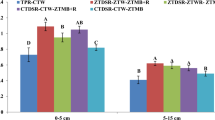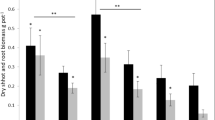Abstract
Allelopathy has been regarded as a mechanism for successful exotic plant invasion. However, it is not clear if and what effects of allelopathic substances may exert on soil nutrient. The exotic plant Mikania micrantha H.B.K. (M. micrantha) has invaded many forests in south China, and recent studies have suggested it has allelopathic potential for other plants and soil microbial community. Thus, we hypothesized that M. micrantha could influence soil nutrients and N transformation through allelopathy. We measured total C and N, NO3 −, NH4 + and pH of the soil beneath M. micrantha and the adjacent open soil, and then measured the above soil properties after treating soil with 3 concentrations of aqueous extracts of M. micrantha (T1: 0.005 g ml−1; T2: 0.025 g ml−1; T3: 0.100 g ml−1). In addition, a bioassay was conducted to determine the allelopathic potential of the soil beneath M. micrantha. The results showed that M. micrantha significantly affected soil nutrients and N transformation. Soil beneath M. micrantha had inhibitory effects on seed germination and seedling growth of test plant, and had significantly higher C, N, ammonia, net nitrification rate than those of open soil. The plant extracts decreased soil pH, and T1 decreased it the most, and it increased soil C and N, and T1 represented the greatest increase in both C and N. The extracts also increased both NO3 − and NH4 + in soil, whereas no significant difference existed among the 3 extract treatments. Compared to the water control, the soil net mineralization rate was higher under T1, while lower under T2 and T3. However, the extracts increased the soil nitrification rates under all the treatments (T1, T2 and T3). Our results suggest that the water soluble allelochemicals of M. micrantha improve soil nutrient availability, through which the invasive plant M. micrantha may successfully invade and establish in new habitats.





Similar content being viewed by others
References
Allison SD, Vitousek PM (2004) Rapid nutrient cycling in leaf litter from invasive plants in Hawai’i. Oecologia 141:612–619. doi:10.1007/s00442-004-1679-z
Bais HP, Vepachedu R, Gilroy S, Callaway RM, Vivanco JM (2003) Allelopathy and exotic plant invasion: from molecules and genes to species interactions. Science 301:1377–1380. doi:10.1126/science.1083245
Batish DR, Singh HP, Pandher JK, Arora V, Kohli RK (2002) Phytotoxic effect of Parthenium residues on the selected soil properties and growth of chickpea and radish. Weed Biol Manage 2:73–78. doi:10.1046/j.1445-6664.2002.00050.x
Caldwell BA (2006) Effects of invasive scotch broom on soil properties in a Pacific coastal prairie soil. Appl Soil Ecol 32:149–152. doi:10.1016/j.apsoil.2004.11.008
Callaway RM (2002) The detection of neighbors by plants. Trends Ecol Evol 17:104–105. doi:10.1016/S0169-5347(01)02438-7
Callaway RM, Aschehoug ET (2000) Invasive plants versus their new and old neighbors: a mechanism for exotic invasion. Science 290:521–523. doi:10.1126/science.290.5491.521
Callaway RM, Ridenour WM (2004) Novel weapons: invasive success and the evolution of increased competitive ability. Front Ecol Environ 2(8):436–443
Callaway RM, Thelen GC, Rodriguez A, Holben WE (2004) Soil biota and exotic plant invasion. Nature 427:731–733. doi:10.1038/nature02322
Callaway RM, Kim J, Mahall BE (2006) Defoliation of Centaurea solstitialis stimulates compensatory growth and intensifies negative effects on neighbors. Biol Invasions 8:1389–1397. doi:10.1007/s10530-006-0003-8
Chen BM, Ni GY, Ren WT, Peng SL (2007) Effects of aqueous extracts of the invasive plant Mikania micrantha on litter decomposition of native plants in South China. Allelopathy J 20(2):307–314
Cronk QCB, Fuller JL (1995) Plant invaders: the threat to natural ecosystems. Chapman and Hall, London, p 241
Drenovsky RE, Batten KM (2007) Invasion by Aegilops triuncialis (Barb Goatgrass) slows carbon and nutrient cycling in a serpentine grassland. Biol Invasions 9(2):107–116. doi:10.1007/s10530-006-0007-4
Ehrenfeld JG (2003) Effects of exotic plant invasions on soil nutrient cycling processes. Ecosystems (N Y, Print) 6:503–523. doi:10.1007/s10021-002-0151-3
Ehrenfeld JG, Kourtev PS, Huang W (2001) Changes in soil functions following invasions of exotic understory plants in deciduous forests. Ecol Appl 11:1287–1300. doi:10.1890/1051-0761(2001)011[1287:CISFFI]2.0.CO;2
Feng HL, Cao HL, Liang XD, Zhou X, Ye WH (2002) The distribution and harmful effect on Mikania micrantha in Guangdong. J Trop Subtrop Bot 10:263–270
Hawkes CV, Wren IF, Herman DJ, Firestone MK (2005) Plant invasion alters nitrogen cycling by modifying the soil nitrifying community. Ecol Lett 8:976–985. doi:10.1111/j.1461-0248.2005.00802.x
Hierro JL, Callaway RM (2003) Allelopathy and exotic plant invasion. Plant Soil 256:29–39. doi:10.1023/A:1026208327014
Hierro JL, Maron JL, Callaway RM (2005) A biogeographical approach to plant invasions: the importance of studying exotics in their introduced and native range. J Ecol 93:5–15. doi:10.1111/j.0022-0477.2004.00953.x
Ismail BS, Chong TV (2002) Effects of aqueous extracts and decomposition of Mikania micrantha H.B.K. debris on selected agronomic crops. Weed Biol Manage 2:31. doi:10.1046/j.1445-6664.2002.00045.x
Kourtev PS, Ehrenfeld JG, Häggblom M (2002) Exotic plant species alter the microbial community structure and function in the soil. Ecology 83:3152–3166
Kourtev PS, Ehrenfeld JG, Häggblom M (2003) Experimental analysis of the effect of exotic and native plant species on the structure and function of soil microbial communities. Soil Biol Biochem 35:895–905. doi:10.1016/S0038-0717(03)00120-2
Li WH, Zhang CB, Jiang HB, Xin GR, Yang ZY (2006) Changes in soil microbial community associated with invasion of the exotic weed, Mikania micrantha H.B.K. Plant Soil 281:309–324. doi:10.1007/s11104-005-9641-3
Mengel K, Kirkby EA (1982) Principles of plant nutrition. International Potash Institute, Worblaufen-Bern, Switzerland, pp 342–343
Miki T, Kondoh M (2002) Feedbacks between nutrient cycling and vegetation predict plant species coexistence and invasion. Ecol Lett 5:624–633. doi:10.1046/j.1461-0248.2002.00347.x
Neill C, Piccolo MC, Cerri CC, Steudler PA, Melillo JM, Brito M (1997) Net nitrogen mineralization and net nitrification rates in soils following deforestation for pasture across the southwestern Brazilian Amazon Basin landscape. Oecologia 110:243–252. doi:10.1007/s004420050157
Ni GY, Peng SL (2007) Research advances in the interactions between allelopathy and soil in exotic plant invasions. Ecol Environ 16(2):644–648
Ni GY, Song LY, Zhang JL, Peng SL (2006) Effects of root extracts of Mikania micrantha H.B.K. on soil microbial community. Allelopathy J 17:247–254
Ni GY, Li FL, Chen BM, Song LY, Peng SL (2007) Allelopathy of invasive plant—Mikania micrantha H.B.K. Allelopathy J 19:287–296
Ridenour WM, Callaway RM (2001) The relative importance of allelopathy in interference: the effects of an invasive weed on a native bunchgrass. Oecologia 126:444–450. doi:10.1007/s004420000533
Shao H, Peng SL, Zhang C, Nan P (2003) Allelopathic potential of Mikania micrantha. Chin J Ecol 22:62–65
Shao H, Peng SL, Wei XY, Zhang DQ, Zhang C (2005) Potential allelochemicals from an invasive weed Mikania micrantha H.B.K. J Chem Ecol 31:1657–1668. doi:10.1007/s10886-005-5805-0
Thorpe AS, Archer V, DeLuca TH (2006) The invasive forb, Centaurea maculosa, increases phosphorus availability in Montana grasslands. Appl Soil Ecol 32:118–122. doi:10.1016/j.apsoil.2005.02.018
Vaughn SF, Berhow MA (1999) Allelochemicals isolated from tissues of the invasive weed garlic mustard (Alliaria petiolata). J Chem Ecol 25:2495–2504. doi:10.1023/A:1020874124645
Vitousek PM, Walker LR (1989) Biological invasion by Myrica faya in Hawaii-plant demography, nitrogen-fixation, ecosystem effects. Ecol Monogr 59:247–265. doi:10.2307/1942601
Vitousek P, Walker L, Whiteaker L, Mueller-Dombois D, Matson P (1987) Biological invasion by Myrica faya alters ecosystem development in Hawaii. Science 238:802–803. doi:10.1126/science.238.4828.802
Wang BS, Liao WB, Zan QJ, Li MG, Zhou XY, Gao SH (2003) The spreads of Mikania micrantha in China. Acta Sci Nat Univ Sunyatseni 42:47–50
Wolfe BE, Klironomos JN (2005) Breaking New Ground: Soil Communities and Exotic Plant Invasion. Bioscience 55:477–487. doi:10.1641/0006-3568(2005)055[0477:BNGSCA]2.0.CO;2
Wu JR, Peng SL (2005) Allelopathy: ‘Novel weapons’ of exotic invasive plants. Acta Ecol Sin 25(11):3093–3097
Zan QJ, Wang YJ, Wang BS, Liao WB, Li MG (2000) The distributionan d harm of the exotic weed Mikania micrantha. Chin J Ecol 19:58–61
Zhang WY, Wang BS, Liao WB, Li MG, Wang YJ, Zan QJ (2002) Progress in studies on an exotic vicious weed Mikania micrantha. Chin J Appl Ecol 13:1684–1688
Zhang LY, Ye WH, Cao HL, Feng HL (2004) Mikania micrantha H.B.K. in China—an overview. Weed Res 44:42–49
Acknowledgements
We thank Prof. Jiang-Ming Mo and Zhong-Liang Huang for their valuable suggestions and help in the study. We also thank the colleagues of Dinghushan Forest Experimental Station for their help in completing the experiments. The study was supported by the National Natural Science Foundation of China (30670385, U0633002) and the Key Program of Ministry of Education of China (704037).
Author information
Authors and Affiliations
Corresponding author
Rights and permissions
About this article
Cite this article
Chen, BM., Peng, SL. & Ni, GY. Effects of the invasive plant Mikania micrantha H.B.K. on soil nitrogen availability through allelopathy in South China. Biol Invasions 11, 1291–1299 (2009). https://doi.org/10.1007/s10530-008-9336-9
Received:
Accepted:
Published:
Issue Date:
DOI: https://doi.org/10.1007/s10530-008-9336-9




